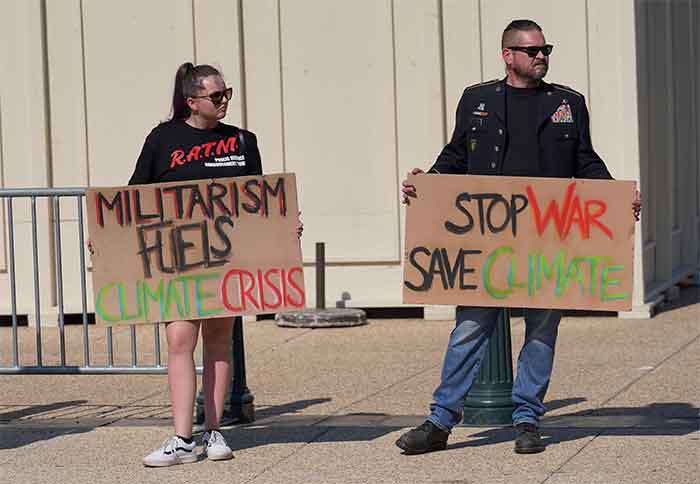
As with all things military, the Army has created an anachronism for correcting its negative impact on the environment and climate titled, the Army Climate Strategy (ACS), setting “targets” to address their massive negative contribution to climate change. The Army is the first service branch in the DOD to release such a climate strategy to meet both short term and future goals in reducing greenhouse gasses.
The combined military branches are some of the largest users of fossils fuels and other forms of energy with the Air Force and the Navy being the largest emitters of all the services in their operations.
Addressing the ACS program and its expected outcomes, Paul Farnan, Principal Deputy Assistant Secretary of the Army for Installations, Energy and Environment, and Sharon Burke, former Assistant Secretary of Defense for Operational Energy Plans and Programs for the Department of Defense (DOD) spoke at the Center for Strategic and International Studies to relate how the Army will attack its environmental impact moving forward.
The military’s contributions to global climate change have been a cause that activists through numerous demonstrations have rallied against for the past decade to see the military take ownership of and implement to impose a reduction plan of action along with ending all wars. Just recently here in Washington several climate activists from Veterans For Peace were arrested at the Capitol while demonstrating under the banner of “Militarism Fuels Climate Crisis.” The arrests took place when they blocked the street in front of the Capitol while attempting to call attention to their cause.
It is often said that an army runs on its stomach but to feed that stomach and to supply and maintain its multiple operations an army needs massive amounts of fossil fuel and energy sources of all sorts.
With operations becoming more technical and increasingly dependent and vulnerable on the supply of energy the time to transition into a greener source has now become an imperative.
In speaking to the reduction of greenhouse gas emissions in the report Paul Farnan related two high-level goals. “One is a 50 percent emissions reduction by 2030 as measured from a 2005 baseline. Another is a net-zero emissions target by 2050 with full hybridization by the end of this decade. The implementation plan talks about near-term objectives, tasks, metrics and resources to support those long-term goals. We started with the climate strategy a year ago really because climate is not some futuristic threat that’s kind out there in the universe somewhere. Climate change is actually affecting the Army today, right now.”
In addressing what area of the Army uses the most fossil fuel, he went on to indicate that Army installations “burn most of our fuel, and that’s where a lot of greenhouse gases are going to come from.”
Because of the logistics in the acquisition, transportation and supplying of fossil fuels, the Army exposes troops and facilities to greater risk by having to protect convoys’ movements when advancing on the battlefield. A recent example of forward advancement without logistical support was seen in Ukraine when Russian tanks sat idle and vulnerable to attack for lack of fuel and other supplies necessary for its operation.
Therefore, a greener approach is likely to save lives and assist in creating a need for less fuel by establishing bases that are self-contained and less endangered of being disrupted in their operations. The report is calling for the use of electric vehicles (EV) and more use of solar, wind and isolated systems that operate independently from the energy grid.
Much of how these changes will be made and what technologies will be utilized in their solution will come with time as the technical side evolves and innovations and inventions come online. In terms of educating the military establishment in general it was announced that the military academy at West Point Military Academy has implemented in its curriculum a climate impact course for future officers that includes sustainability and resilience in an ever-changing operational environment. Additionally, war gaming, an experiential learning tool will soon be incorporating climate scenarios as part of its strategy to evolve to the new challenges the world is facing.
As seen in the aftermath of WWII and the NASA space program in the last century, a great deal of spin off will eventually arrive for civilian use as the military innovates and creates new solutions to address 20th century impact problems. Examples such as microwave ovens, GPS and digital watches are among those innovations that have transformed our daily lives.
“War’s not about the environment; it’s a consumptive and destructive activity” was how Sharon Burke related the matter. While she agreed that the military’s environmental impact could and should be lessened, she pointed out its deplorable environmental consequences in the U.S. where “There are still something like 600 military Superfund sites out there and a lot of them are Cold War legacy sites.”
While war won’t be going away any time soon, any movement to lessen the military’s impact on global climate change will help in that ongoing struggle.
Lastly, she also noted that “Congress was active and wanted to make a more effective military to minimize the risk to fielded forces and to lower the costs at the time.” Becoming greener and more environmentally responsible will go a long way in achieving that goal.
Report and photos by Phil Pasquini
© 2022 nuzeink all rights reserved worldwide
(This article has previously appeared in Nuzeink.)
Phil Pasquini is a freelance journalist and photographer. His reports and photographs appear in the Washington Report on Middle East Affairs, Pakistan Link and Nuze.ink. He is the author of Domes, Arches and Minarets: A History of Islamic-Inspired Buildings in America.















































